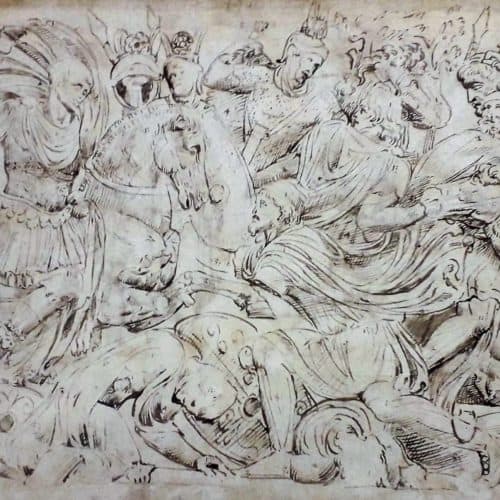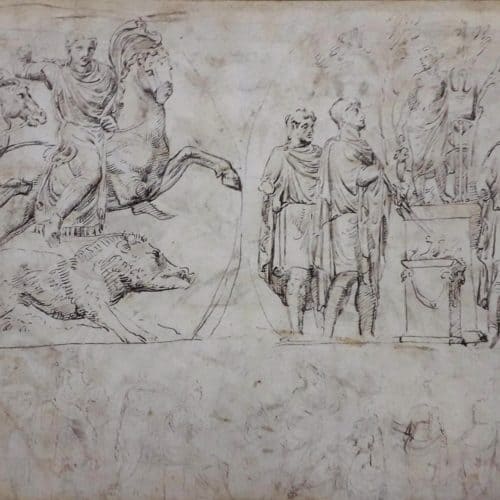Master Collection 20: drawings from the Roman Arch of Constantine
Copy of Trajanic frieze on the Arch of Constantine, Rome. Unknown artist. Pencil, pen and brown ink, and brown wash on paper.
This drawing depicts a battle, with cavalrymen and foot soldiers.
The men in armour are Roman soldiers. They are wearing plumed helmets and body armour or ‘cuirasses’. The man on the left with a flying cloak but no helmet is thought to represent the emperor Trajan.
The men without armour are Dacians – ‘barbarians’ from the area of central Europe now in Romania.
The battle scene is a Roman sculpture from the time of Trajan. It is a relief sculpture from the Great Trajanic Frieze that was once in the Basilica Ulpia in Trajan’s Forum, Rome.
During the time of the emperor Constantine, before the fall of the Roman Empire, this sculptural relief was removed from its original location and incorporated in a new Arch of Constantine. This arch reused many Roman sculptures from the time of earlier emperors. It showed that Constantine was paying tribute to his predecessors but also made him their equal.
The battle relief is located inside the middle arch.
Two other Roman relief sculptures from the Arch of Constantine are drawn on the reverse of this sheet of paper. See next image.
The Arch of Constantine is a very prominent monument in Rome, immediately next to the Colosseum. Roman sculptures on the arch were among the most visible and easily accessible in Rome from the 16th to 19th centuries. Many artists could see and draw them. Turner, when he visited Rome in 1819, made studies of them, including this battle scene.
The composition of the Trajanic battle scene influenced Raphael in one of his Renaissance wall paintings for the Vatican in Rome.
Copy of Roman reliefs on the Arch of Constantine, Rome. Unknown artist. Pencil, pen and brown ink, and brown wash on paper.
On the left of the drawing is a depiction of a Roman boar hunt. Toga-clad Romans on horseback – the emperor Hadrian and his men - are attacking a wild boar. Can you see its rough skin, hooves and fangs?
On the right of the drawing is depicted a Roman sacrifice to a deity. Two men in togas, representing the emperor Hadrian and a companion, stand on the left of an altar. A sacrifice is burning in front of a sculpture of the Roman god Apollo, recognisable by the lyre he holds. To the right of the altar a toga-clad man is holding a horse for Hadrian.
On the bottom of the drawing is a pencil sketch of Roman figures, some of them standing and others seated. They are part of a relief sculpture from the time of Constantine. Only a few of the sketches have been worked over in pen and ink. The artist made a pencil sketch first because you can’t rub out ink lines.
The two larger scenes are copies of Roman sculptural reliefs in the form of medallions from the time of the emperor Hadrian.
The sketch along the bottom is from a long narrow frieze made in the time of Constantine. The frieze was installed below the two medallions on the Arch of Constantine in Rome. This arch reused many sculptures from the time of earlier emperors. It showed that Constantine was paying tribute to his predecessors but also made him their equal.
The medallions and frieze are above one of the smaller side arcs of the Arch of Constantine. They face the Roman Forum.
A relief sculpture of a battle scene from inside the central arc of the Arch of Constantine is drawn on the other side of this sheet of paper.
The Arch of Constantine is a very prominent monument in Rome, immediately next to the Colosseum. Roman sculptures on the arch were among the most visible and easily accessible in Rome from the 16th to 19th centuries. Many artists could see and draw them.


